Assessing Water Quality in Natural Urban Wetlands
Project Summary
Impacts to wetlands and streams are disproportionately occurring in urban areas, both from newly permitted projects and from lack of stormwater treatment from historical development. Data are lacking on water quality functions of natural wetlands receiving stormwater runoff in urban settings.
The Division of Water Resources’ recent study of urban wetland water quality involved collecting regular water samples at the permanently flowing inlets, centers, and flowing outlets of 4 intensive study wetlands and 8 supplemental wetlands to determine how (or whether) they were affecting water quality in urban settings. The study was carried out on wetlands in the heart of Raleigh, North Carolina, along Walnut Creek. Water samples were analyzed for heavy metals, nutrients (often from fertilizer and pet waste), oil and grease, and suspended solids.
Along with field data collection in natural wetlands, existing documented research on water quality benefits of constructed stormwater wetlands was compiled and summarized for comparison with natural wetland systems in urban settings.
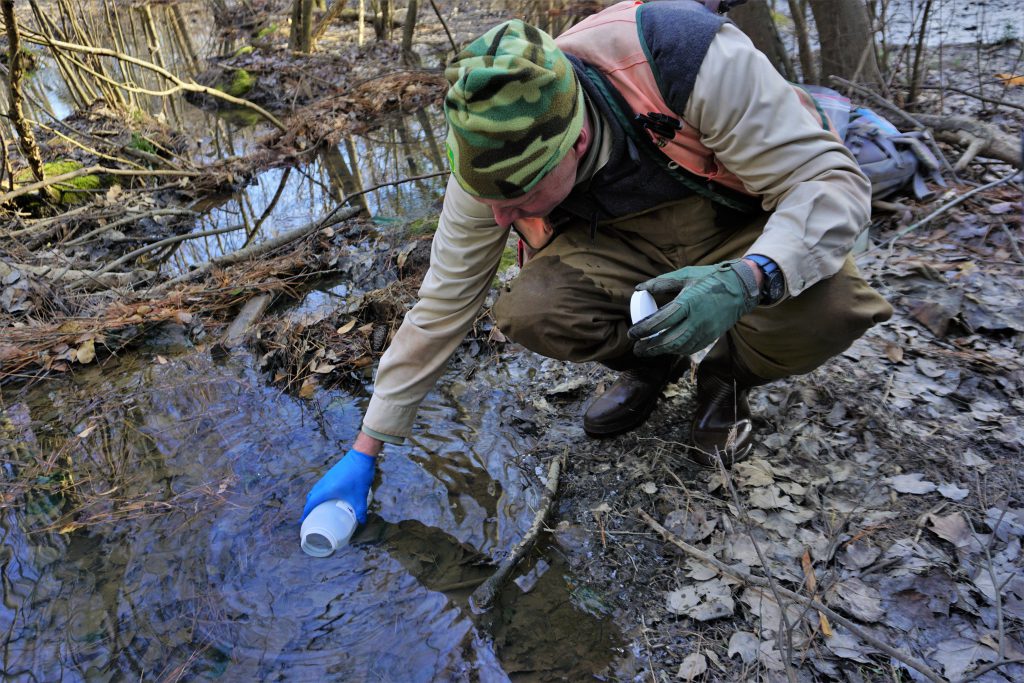
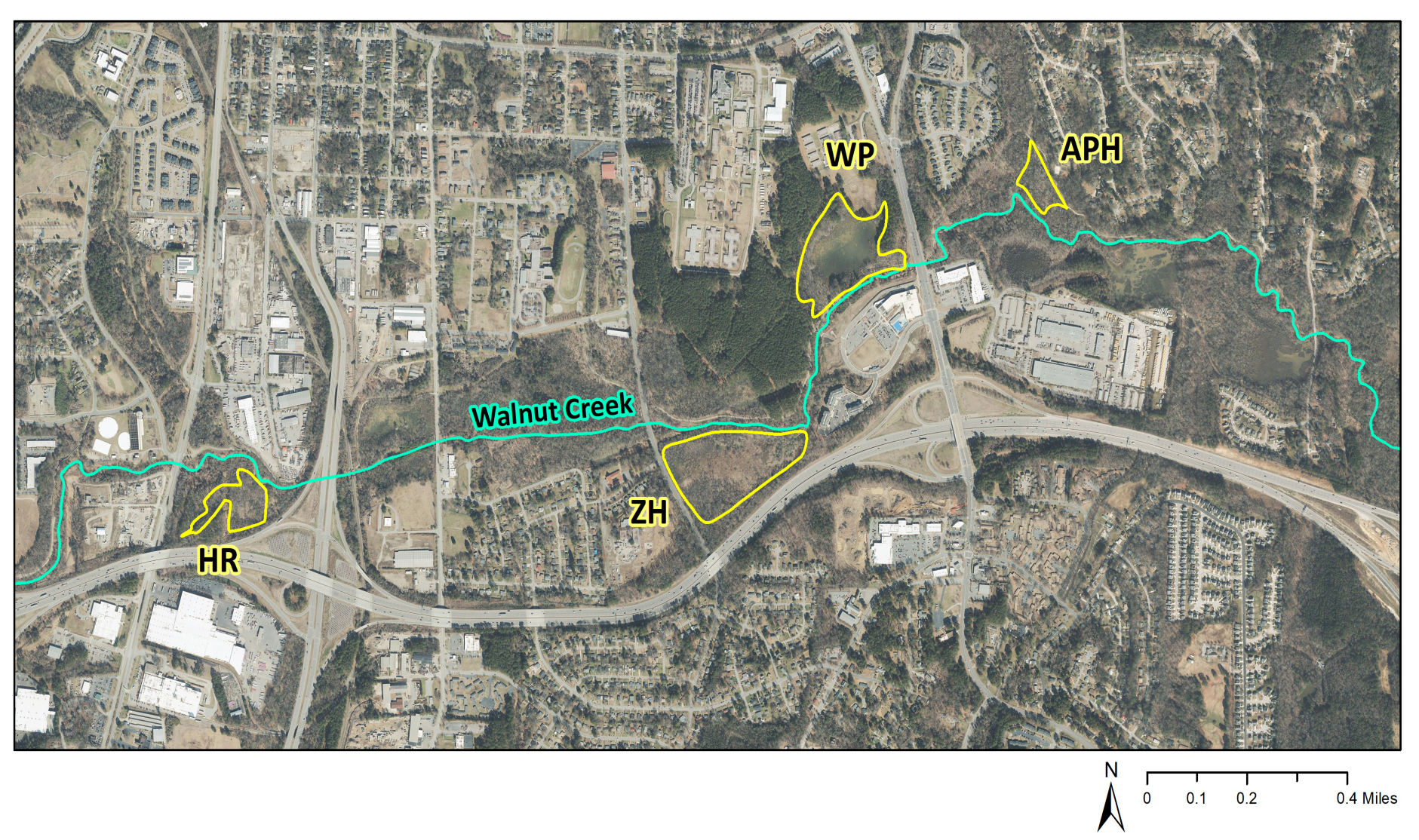
Map of intensive study wetlands along Walnut Creek in south Raleigh
Summary of Results
Oil and grease were nearly always undetectable in water samples. Nutrient and metal concentrations were generally low enough to be considered at background levels, in inlets and outlets. Nitrate/nitrate was the only parameter to show statistically significantly lower concentrations at outlets compared to inlets. Copper, lead, and zinc concentrations were higher in wetland centers than at inlets, suggesting sequestering of metals by the large amounts of algae biomass commonly present in the wetland centers. This difference disappeared during stormflow, probably because of dilution. During baseflow conditions, the urban study wetlands output copper and lead into Walnut Creek, possibly because of beaver dam interference with the free-flowing status of the outlet tributaries. However, the concentrations being output still amounted to extremely small portions of the total loadings in the Creek itself. Lead levels in the wetland soils were high in some wetlands, indicating that legacy lead from leaded fuel had been sequestered in wetland sediments, but lead was not proportionately being suspended into the water. Total suspended solids were significantly higher in the water at outlets than inlets at baseflow times, but a detailed sediment movement assessment at one study wetland suggested that overall sediment coming into the wetland during storms was a much greater volume than that exiting the outlet through bank erosion.
Concentrations of measured contaminants were quite low in general, making uplift between inlet and outlet difficult to detect. However, these low concentrations underscore the function and importance of intact vegetated buffers on streams and waterbodies in urban areas. Additionally, we recorded significant accumulation of sediment (about 80 dump truck loads over 24 months), only 7% of which was eroding at the outlet to the mainstem Walnut Creek. The urban wetlands in this study were functioning to capture sediment which otherwise would have stayed in or entered Walnut Creek and the Neuse River. Large quantities of discarded trash, mostly plastic, have also been trapped by the urban study wetlands, providing a capture mechanism that would be absent without them.
A literature review of performance of constructed stormwater wetlands is included in the final report. Constructed stormwater wetlands are generally sized and designed for the specific inputs they receive, which makes their contaminant removal effectiveness high in the first years after construction. Secondly, because constructed stormwater wetlands tend to fill up with sediments over time and they are seldom maintained in the long term, their effectiveness often dramatically decreases over time. Thirdly, any unexpected contaminant inputs may not be able to be absorbed, since the original design tends to be limited to specific contaminants. Natural urban wetlands tend to be larger in size and have the vegetation and structural capacity to capture a range of contaminants, especially sediment and plastic. That said, functioning constructed wetlands can deal with much higher contaminant loads than what we encountered coming into our natural study wetlands.
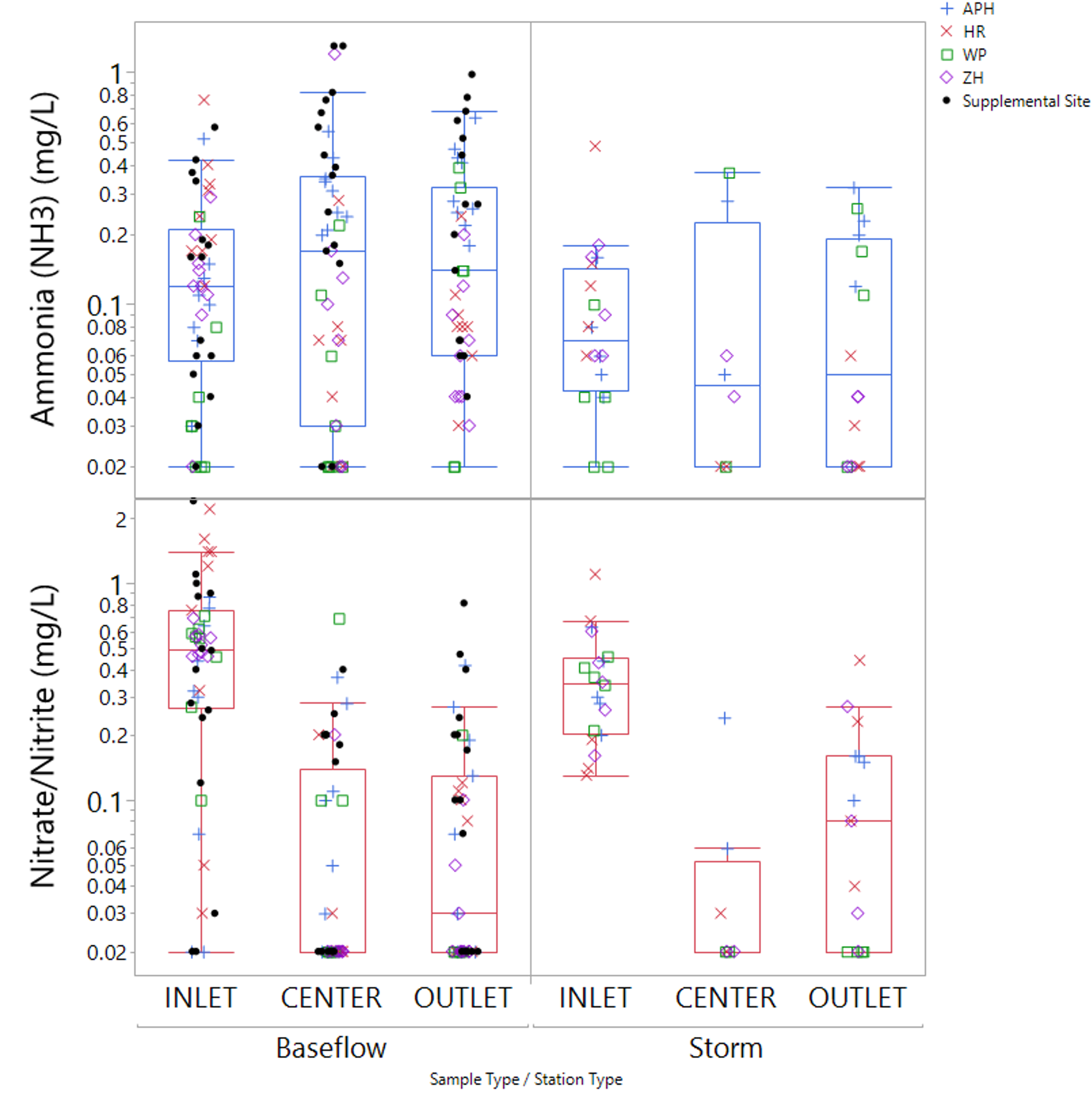
Nitrate/nitrite concentrations were significantly lower exiting the wetlands
The results from this data collection cannot indicate at what high levels of contamination (amounts typically not found in relatively unurbanized or otherwise undisturbed areas but also not found in this study area), introduced into the natural wetlands of Raleigh through surface water, would overwhelm these wetlands and make them unable to keep these contaminants from entering Walnut Creek. Therefore, it is not possible to directly compare stormwater uplift capability of these wetlands with operating constructed stormwater BMPs for a similar suite of contaminants.
However, it is clear that Raleigh City wetlands are performing invaluable ecologically and water quality-enhancing services to the City and without any direct or indirect cost. Tons of nuisance and even potentially dangerous public waste materials, hundreds of dump truck loads worth of cubic meters of eroded sediment, and high amounts of heavy metals in the soils are being kept from the lower Walnut Creek watershed and by extension the Neuse River basin by the self-maintaining, trapping action of these forested marshes and ponds. In addition, millions of gallons of flood waters are being slowed, if not stored long-term, from entry into the downstream watershed by these sites every year, through both growing and non-growing seasons. These wetlands and the local catchment buffers associated with them, should not be infringed upon or impaired to protect these cost-free, self-sustaining services for the City, Wake County, and the other downstream municipalities connected to the Neuse River.
Major Findings
- Baseflow and storm event concentrations in wetland inlet and outlet streams at all sites were very low levels compared to what are considered high concentrations in the literature. Median concentrations could be considered to be at background levels.
- Intermittent high concentrations of metals in the sampled water of the centers of the intensive study wetlands relative to inlet water can be explained by accretion and holding of metal-carrying sediment by wetland vegetation in those areas but also by the bioabsorption and bioaccumulation (die-off) of in-situ algal colonies. Terrestrial algae of the general type inhabiting the study wetland marshes are known sequesters of heavy metals (Ellison et al. 2014; Jahan et al. 2004; Matei et al. 2015). This effect is likely also responsible for slightly higher concentrations of metals in output versus inlet waters at certain sample events.
- When compared to concentrations and flow in Walnut Creek, the intensive study wetlands were not contributing appreciable pollutants to the mainstem of Walnut Creek. With the exception of nitrate/nitrite, concentrations of measured parameters were always lower in the Creek than in wetlands inlets/outlets, during baseflow and storm situations. We calculated no appreciable loadings being input into Walnut Creek from these wetlands during storms while Walnut Creek was still significantly above baseflow stage. We did calculate some reduction in loadings from inlet to outlet depending on wetland, storm event and parameter. Site outlet flows also contributed a very small fraction of the total water flowing through the mainstem channel adjacent to the study sites, regardless of storm size.
- Attempts at estimating pollutant loadings made it clear that natural wetlands can display a wide range of loadings behavior from event to event versus engineered wetlands where the physical environment (ie. inlet and outlet sizes and configurations [e.g., pipes], hydraulic vectors impinging on the wetland area, etc.), can be under much more direct human control.
- The relatively low levels of contamination in the study sites influent water at baseflow and during storms were most likely attributable to the upland subcatchments’ effectiveness at cleaning stormwater, along with the apparent lack of significant parameter input from subcatchment surfaces. Much of the subcatchment areas contained well-established neighborhoods dating from immediately after World War II and included large trees, cumulatively extensive unfertilized lawns, and large amounts of buffer vegetation along tributaries and the mainstem of Walnut Creek. There were no large parking lots and only light industry extent in the areas of the intensive study wetlands. Any possible below-ground leakage was not apparent in the study site surface waters. This study gives strong on-the-ground evidence of the effectiveness and necessity of maintained stream buffers. Developing and infilling parcels in downtowns of cities is often desired, but it is critical that planners and developers carefully avoid disturbing established buffers that enable contamination capture.
- The study wetlands showed significant trapping of sediment; we estimated several hundred cubic meters of sand and silt with a small percentage (7%) being eroded into Walnut Creek from the wetland stream outlets. There was also significant long-term (months to perhaps years) trapping of macro-pollution (plastic trash) which has been kept out of the lower Walnut Creek basin and hence the greater Neuse River Basin.
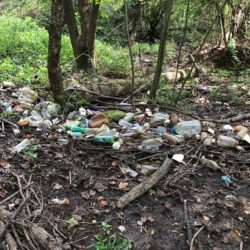
Urban wetlands keep trash from flowing out to the ocean
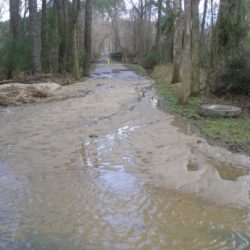
Urban wetlands trap sediment from overflowing streams and creeks
Wetlands in urban areas provide important functions, like habitat for animals, water filtering, green space, and floodwater storage.
This work was funded through US EPA Cooperative Agreement No. CD 00D65017 and matching funds from the NC Department of Environmental Quality.

